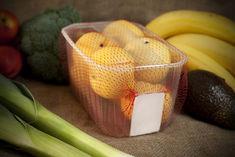
Wandering through the fruit and veg aisles in a French or Spanish supermarket, you’d be hard-pressed to find film-wrapped broccoli or double-packed cucumbers. Chances are produce will be displayed in uncovered crates, tempting you to pick up and smell a vine-ripened tomato as you add items to your basket.
So how come the picture is so different in Britain? Environmentalists do call for less packaging in the supermarkets, yet what many fail to realise is that the plastic wrapping is sometimes fully recyclable and extends the shelf life of the fruit or vegetable, reducing the amount of food waste in the supply chain.
An example is the New Generation Pack (NGP), a product recently developed by LC Packaging. Unlike traditional netted packaging, which tends to be made of several materials (punnet, plastic net, metal closure, paper label and handle), and has to be divided before discarding or recycling, the NGP is fully recyclable and does not require any separation during disposal.
Essentially a punnet wrapped in a tubular extruded net and two bands of film (one placed on the top and the other one on the bottom of the punnet), this is a 100 per cent recyclable packaging solution, according to the manufacturer. It is made of lightweight materials (polyethylene and polypropylene) with no metal clips, which makes it more environmentally friendly than similar products.
This product has got the attention of one of the big supermarket chains, says Martin Schrooder, managing director of LC Packaging. “For the prepacking industry this is completely new. A major multiple has asked for exclusivity and provided everything goes to plan it could be in stores by the end of February.”
Another company promoting the green agenda is PP Global, which supplies 25 per cent of the packaging for the UK fresh produce industry. Managing director Philip Sleightholme says that over the next few years the supermarkets will be labelling their packaging more clearly to promote it as recyclable. “At the moment, most of it is but is not being labelled as such. Some packaging says it is not recyclable even though it is, others say ‘recyclable where facilities exist’. Waitrose is leading the way in terms of clearly labelling its packaging as recyclable, which will drive consumers and local authorities to recycle more.”
In terms of recycling Sleightholme also predicts some major changes. “Anything that can’t be recycled will be burnt, generating electricity. This is already being done in the Netherlands and Scandinavia.”
As a specialist in reducing the size and thickness of packaging, PP Global is working on a packaging reduction project with Tesco. Among PP’s innovations is a plastic film that is significantly more lightweight than similar products on the market.
Making sure everything is fully recyclable or compostable is key but, according to Sleightholme, the latter is actually not so popular due to the cost involved. “Compostable packaging is actually not as green as you might think - it has quite a large carbon footprint. There hasn’t been enough investment in industrial composting by local authorities. For that reason, it has been ditched by Tesco and Asda,” he explains, adding that improving and simplifying the recycling process is the future.
As an example he describes how in Cambridge, where he lives, people now have (in addition to their black general waste bin) a green bin for organic waste plus a full-size blue wheelie bin for recyclable PET and PE products, such as yoghurt pots and other rigid plastics, apple bags and potato bags, as well as plastics that may have covered cucumbers or prepared salads. The packaging is collected, recycled and put back into the supply chain, either in fresh produce or in other industries, such as car manufacturing or construction - a sustainable system that allows packaging to continue being part of the fresh produce supply chain. “Packaging in fresh produce is essential,” says Sleightholme. “The UK has more fruit and veg packaging compared to other countries, but as a result we have less food waste - and reducing food waste is our biggest goal.”
Nigel Jenney of the Fresh Produce Consortium agrees that packaging is essential. “There are lots of examples of best practice across the fresh produce industry in terms of tackling waste in the supply chain, with energy recovery such as anaerobic digesters, innovative packaging and on-site recycling facilities.” he says.
“The industry has done a great deal to reduce excess packaging, increase re-use and recycling. The development of green packaging is a further tool to assist the industry in meeting the challenges of delivering sustainable food production and we welcome innovations that enhance shelf-life for the consumer, as well as reducing waste in the supply chain, regardless of source.” -



